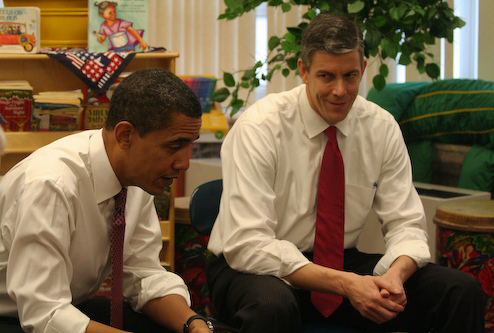
In his State of the Union address last month, President Obama focused heavily on education. One of the President’s main legislative goals this year is to pass his restructuring of the Elementary and Secondary Education Act (ESEA), better known in its current incarnation as No Child Left Behind (NCLB).
The ESEA was signed into law in 1965 and goes through periodic re-authorizations, the most recent of which being in 2001 with No Child Left Behind. Obama aims to modify NCLB and rename it Race to the Top (RTTT). Despite the fact that Obama has been very careful to distance his education plan from George W. Bush’s, which was wildly unpopular, the differences between the two seem minor upon close inspection.
No Child Left Behind is infamous for focusing heavily on standardized testing, and punishing struggling schools that failed to meet improvement benchmarks on time. The education community has been very critical of this focus on improvement as measured by standardized testing. Boston University Political Science Professor and education policy specialist Christine Rossell said that NCLB “has produced massive cheating and teaching to the test.” Since it is vital to the survival of schools that students achieve highly on the tests, teachers and administrators are forced to take steps to ensure that they will get the scores they need. Anyone who was in the public education system in the years after NCLB was passed can attest to the fact that some teachers teach to the test, at times at the expense of other lessons. I can remember entire days being dedicated to test-taking strategy when I was in fifth grade, a time at which test-taking strategies are certainly not part of the curriculum.
When it came time for Obama to outline his own education policy, he was adamant that RTTT would not continue to punish schools for failing to meet goals that Prof. Rossell described as “in some cases impossible to achieve.” Obama said that his policy would instead focus on rewarding those schools and districts that improve. In spirit, RTTT – which only refers to a small portion of Obama’s education budget – does this. According to the US Department of Education, RTTT is a $4.35 billion dollar program. Most of that money is dedicated to statewide reform, while some goes towards allowing states to improve the quality of assessments nationwide. The “race” part of the equation comes in because states must compete for millions of dollars worth of grants.
Of the forty-six states that are participating in the program and submitting plans for improving assessments and teaching methods, only nine (plus the District of Columbia) have been awarded grants so far. On top of this, the average grant was for less than $350,000 for an entire state, while most school district budgets are multi-millions of dollars. How can that amount of money have a significant impact on the state level, let alone the national level? Prof. Rossell echoed this sentiment when she critically said the Race to the Top is “just throwing money” at states, and that the program “won’t make any change” in test scores or achievement levels.
Besides focusing on competition between the states, Obama has also been eager to engender national common academic standards. During his State of the Union, Obama seemed concerned that America’s international education achievement rankings have been falling, especially in science and math. The international education rankings compare completely different school systems with completely different structures and expectations of their students. Even chasing the idea of a population of United States students who are mostly scoring in the proficient level in their exams seems like an impossible pursuit – and not because American students are inherently incapable of scoring highly. Prof. Rossell explains, “as soon as we see everyone bunched at the top, you know what we’ll do? We’ll redo the test.” In other words, as soon as a high percentage of students test at the proficient level, the test will be recalibrated to make sure that fewer students receive the highest scores, essentially making it impossible to ever achieve the goal of most students testing in the proficient level.
On top of these problems, many in the education community are highly skeptical of the plan. A highly acclaimed documentary titled “Race to Nowhere” details many of the problems education in America faces, and education experts, talking heads, and groups such as the National Urban League have all voiced serious concerns with the plan’s ability to affect real change in the lives of struggling students. These criticisms of Obama’s education plan are nothing new. They are essentially the same criticisms that were levied against No Child Left Behind – and rightfully so. The two plans are extremely similar, both carrying an emphasis on standardized testing and grade-level achievement. Obama claims that his plan will be more flexible, and while that may be true, it certainly will not miraculously achieve the goals it has set for itself with its current finance plan. The plan is simply more of the same, with a twist. There is, however, one slice of Obama’s education plan that all of us cynics can get behind (at least the cynics who are paying college tuition) – the $10,000 tuition tax credit. Yes please!

